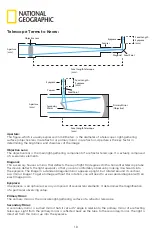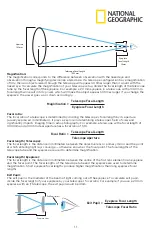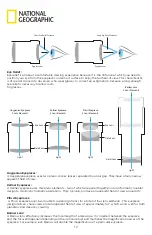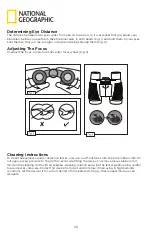
6
Using Your Telescope:
After you have aligned your viewfinder, you are ready to start observing! Put the 20 mm eyepiece into
the focuser to get the widest field of view. This wider field of view will make it easier to locate and track
objects. Use the panhandle to move the scope up, down and side to side until your target comes into
view in the eyepiece. It is important to remember that the rotation of the Earth means objects will move
out of your eyepiece fairly quickly. Once you have found and focused on your desired target, you can
track it as it journeys across the night sky using the panhandle.
To get a closer look at an object, take out the 20 mm eyepiece and replace it with the 12.5 mm eyepiece.
This will increase the magnification to 48x. For the strongest magnification, take out the 12.5 mm
eyepiece and insert the 2x Barlow lens into the diagonal. Put the 12.5 mm eyepiece into the Barlow lens
and secure it in place, this will up the magnification from 48x to 96x. If you use the Barlow lens with
the 26 mm eyepiece, the magnification will
change from 30x to 60x.
Note: Terrestrial objects will appear
reversed due to the optical setup. This
rotation is perfectly normal for a refractor
using a standard diagonal, and it will not affect astronomical viewing.
Cleaning:
Your telescope is a precision optical device and keeping the optics free of dust and dirt is crucial for
optimal performance. To clean the lenses (objective and eyepiece) use only a photo-grade soft brush or
a lint-free cloth, like a microfibre cloth. Do not press down too hard while cleaning, as this might scratch
the lens. If necessary, the cleaning cloth can be moistened with an optical glass cleaning fluid and the lens
wiped clean using very little pressure.
The eyepiece is NOT waterproof so do not spray fluids directly
onto the glass or dip it in water. Never use harsh detergents! After you have finished cleaning an
eyepiece, allow it to fully dry before storing.
Make sure your telescope is always protected against dust and dirt. After use, leave it in a warm room to
dry off before storing.
Troubleshooting Guide:
Problem
Solution
No picture
Remove dust protection cap.
Blurred picture
Adjust focus using focus wheel.
No focus possible
Wait for temperature to balance out.
Bad quality
Never observe through a glass surface such as a window.
Viewing object visible in the finder, but
not through the telescope
Align finder to telescope (see instructions)
Despite using star diagonal the picture
is “crooked”
The star diagonal should be vertical in the eyepiece
connection.
Focal Length Eyepiece
Magnification
2x Barlow Lens
600mm
20mm
30x
60x
600mm
12.5mm
48x
96x


























